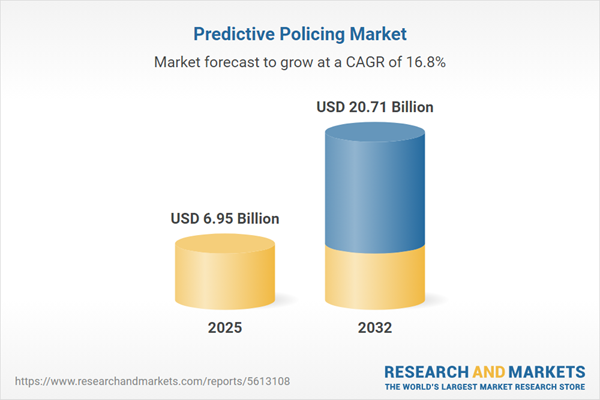Speak directly to the analyst to clarify any post sales queries you may have.
Predictive policing is reshaping decision-making for law enforcement agencies and public safety organizations, providing actionable insights and operational efficiencies through advanced data analytics. The evolving security environment is driving a new wave of digital transformation as agencies prioritize proactive, intelligence-led strategies for crime prevention and resource deployment.
Market Snapshot: Predictive Policing Market Size & Growth
The Predictive Policing Market grew from USD 5.96 billion in 2024 to USD 6.95 billion in 2025. It is expected to continue growing at a CAGR of 16.84%, reaching USD 20.71 billion by 2032. This surge reflects the growing need for law enforcement and security agencies to leverage artificial intelligence, machine learning, and geospatial analytics for enhanced situational awareness and proactive response capabilities. Investment is further driven by emerging threats, rising urbanization, and the proliferation of digital data sources, moving the sector beyond traditional crime mapping and into real-time decision support.
Scope & Segmentation
- End User: Police departments at federal, local, and state levels; private security firms; public safety agencies.
- Application: Crime forecasting (property crime prediction, violent crime prediction); resource allocation (patrol optimization, staffing forecasting); risk assessment (event risk analysis, suspect profiling); threat detection (anomaly detection, suspicious activity recognition).
- Offerings: Services (consulting, integration, support and maintenance) and solutions (analytics, visualization).
- Technology: Data mining (classification, clustering, regression); geo mapping (GIS software, spatial analysis tools); machine learning (reinforcement learning, supervised learning, unsupervised learning).
- Region: Americas (North America: United States, Canada, Mexico. Latin America: Brazil, Argentina, Chile, Colombia, Peru); Europe, Middle East & Africa (Europe: United Kingdom, Germany, France, Russia, Italy, Spain, Netherlands, Sweden, Poland, Switzerland; Middle East: United Arab Emirates, Saudi Arabia, Qatar, Turkey, Israel; Africa: South Africa, Nigeria, Egypt, Kenya); Asia-Pacific (China, India, Japan, Australia, South Korea, Indonesia, Thailand, Malaysia, Singapore, Taiwan).
- Companies Covered: Palantir Technologies Inc., International Business Machines Corporation, SAS Institute Inc., Motorola Solutions, Inc., NICE Ltd., NEC Corporation, Verint Systems Inc., Microsoft Corporation, Cisco Systems, Inc., SAP SE.
Key Takeaways for Senior Decision-Makers
- Predictive policing models are enabling agencies to move from reactive to anticipatory crime prevention, using real-time analytics and pattern recognition to optimize resource allocation and response strategies.
- Decision-makers are adopting machine learning algorithms to enhance the accuracy of risk assessments and streamline patrol deployments, addressing complex crime patterns and emerging threats.
- Cross-sector collaboration among technology providers, academic institutions, and public safety entities is expanding, fostering advanced solutions integration and knowledge sharing.
- Integration of cloud computing and edge analytics supports flexible deployments, allowing agencies to align infrastructure with local regulatory and operational requirements.
- Ethical frameworks and data governance remain central to technology adoption, focusing on transparency, privacy safeguards, and maintaining public trust throughout the implementation process.
- Vendors offer modular, scalable platforms, supporting interoperability with legacy systems as well as new sensor networks, driving operational efficiency in diverse regional settings.
Tariff Impact: United States 2025 Policy Shifts
Upcoming United States tariffs on imported servers, sensors, and proprietary software are affecting procurement strategies and implementation costs for predictive policing solutions. Agencies are responding by exploring domestic sourcing, negotiating long-term vendor contracts, and adopting hybrid cloud-on-premises deployment models. Adjustments in fiscal planning and supplier relationships are necessary to mitigate the risks posed by pricing volatility, supply chain delays, and evolving compliance requirements. These tariff changes require closer attention to technology roadmaps and risk management planning to ensure sustainable access to critical analytic capabilities.
Methodology & Data Sources
Research for this report combines structured interviews with law enforcement leaders, technology vendors, and policy experts, alongside secondary analysis of prominent industry publications, academic journals, and government documents. Each insight is validated through triangulation, peer reviews, and scenario analyses to ensure accuracy and actionable relevance for senior stakeholders.
Why This Report Matters
- Enables senior leadership to benchmark predictive policing adoption against global best practices and evolving regional regulatory landscapes.
- Provides strategic guidance on technology selection, process integration, and risk management to support successful transformation initiatives.
- Helps optimize procurement choices by analyzing factors such as supply chain resilience, interoperability, and compliance in fast-changing markets.
Conclusion
Predictive policing is shaping the operational landscape for public safety agencies worldwide. This report delivers the insights needed for senior decision-makers to drive effective technology adoption and long-term security outcomes. Access detailed segmentation, regional trends, and vendor profiles to support informed, forward-looking strategies.
Additional Product Information:
- Purchase of this report includes 1 year online access with quarterly updates.
- This report can be updated on request. Please contact our Customer Experience team using the Ask a Question widget on our website.
Table of Contents
3. Executive Summary
4. Market Overview
7. Cumulative Impact of Artificial Intelligence 2025
List of Figures
Samples

LOADING...
Companies Mentioned
The key companies profiled in this Predictive Policing market report include:- Palantir Technologies Inc.
- International Business Machines Corporation
- SAS Institute Inc.
- Motorola Solutions, Inc.
- NICE Ltd.
- NEC Corporation
- Verint Systems Inc.
- Microsoft Corporation
- Cisco Systems, Inc.
- SAP SE
Table Information
| Report Attribute | Details |
|---|---|
| No. of Pages | 198 |
| Published | October 2025 |
| Forecast Period | 2025 - 2032 |
| Estimated Market Value ( USD | $ 6.95 Billion |
| Forecasted Market Value ( USD | $ 20.71 Billion |
| Compound Annual Growth Rate | 16.8% |
| Regions Covered | Global |
| No. of Companies Mentioned | 11 |







